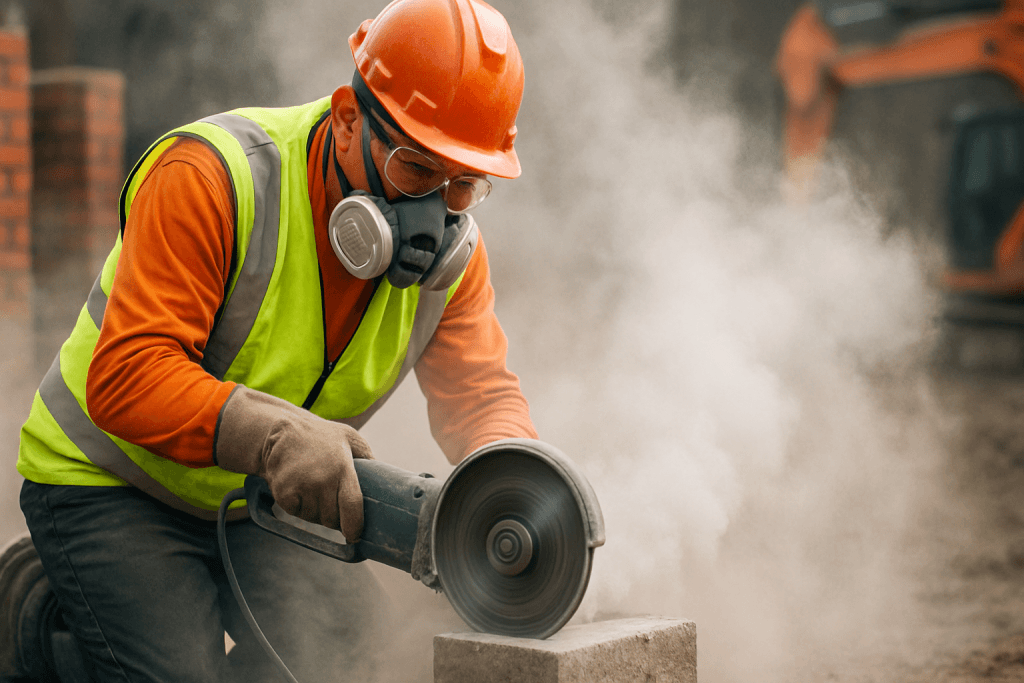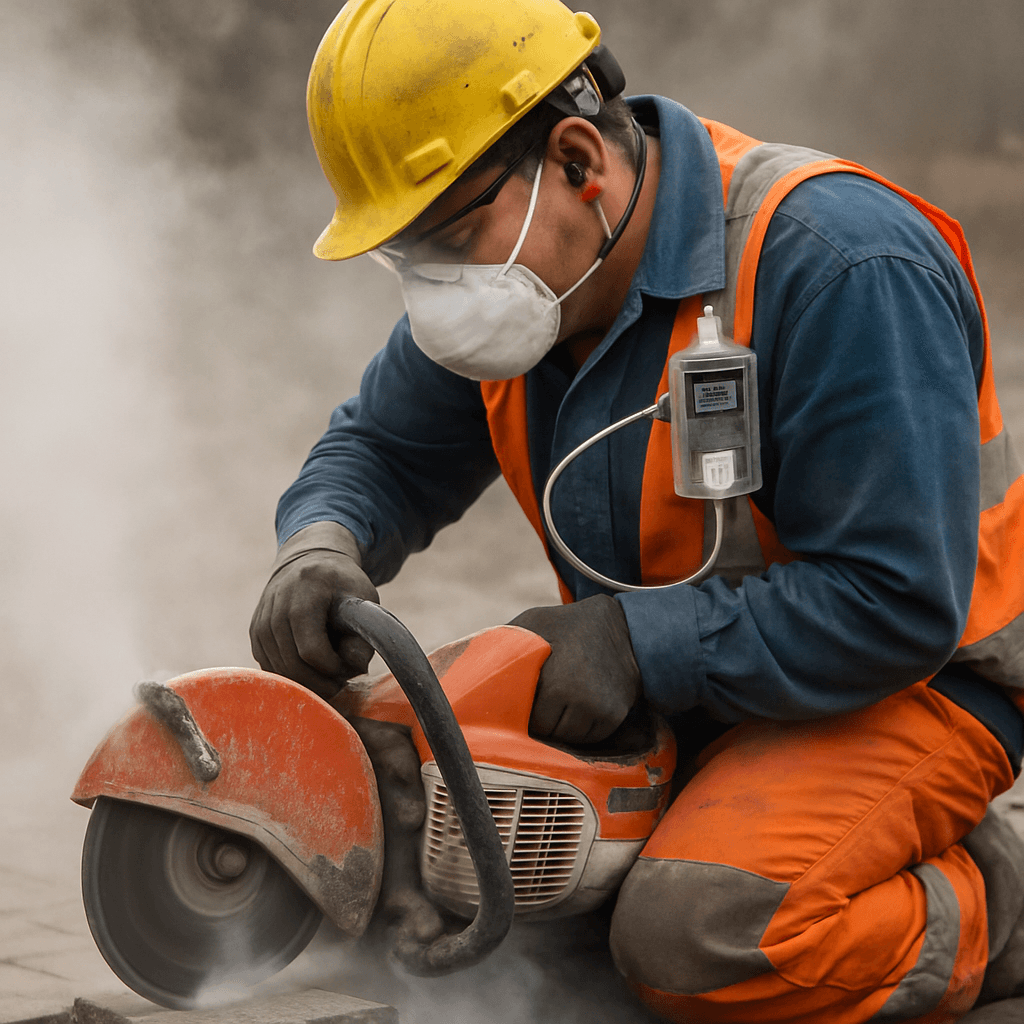TEST
Respirable Crystalline Silica Assessment Service

What is crystalline silica and why does it matter?
- Under the Australian States Work Health and Safety (WHS) regulations and/or Occupational Health and Safety (OH&S) Regulations , a Person Conducting a Business or Undertaking (PCBU) must manage health and safety risks associated with hazardous substances, including respirable crystalline silica (RCS).
- PCBUs must ensure worker exposure to RCS is below the Workplace Exposure Standard (WES) of 0.05 mg/m³ (8-hour time weighted average), keeping exposure as low as reasonably practicable.
- Air monitoring and exposure assessment must be conducted when workers might inhale silica dust, to measure airborne RCS accurately and ensure compliance with exposure limits.
- If exposure risks remain, PCBUs are required to implement the hierarchy of controls: engineering controls (such as local exhaust ventilation and wet methods), administrative controls, and respiratory protective equipment (RPE).
- Health surveillance programs must be in place when exposure cannot be fully eliminated, to monitor worker health and prevent occupational diseases like silicosis.
- Conducting risk assessment of silica exposure is a regulatory requirement before undertaking work involving crystalline silica processes.
Occupational Hygiene & OHS Solutions (OHOS) Pty Ltd Services for RCS
Occupational Hygiene & OHS Solutions (OHOS) Pty Ltd provides comprehensive respirable crystalline silica air monitoring and exposure assessment services tailored to various industries. Our approach includes:
- Air Monitoring and Sample Analysis:
Using state-of-the-art personal and area sampling equipment, we collect air samples to measure respirable crystalline silica concentrations in the workplace. All samples are analyzed by National Association of Testing Authorities (NATA)-accredited laboratories to ensure accuracy and compliance. - Exposure Risk Assessments:
We identify high-risk tasks and environments where silica dust is generated, helping you understand potential exposure sources. - Control Measures Recommendations:
Based on monitoring results, we advise on effective control strategies including engineering solutions like local exhaust ventilation and wet cutting methods, administrative controls, and proper use of respiratory protective equipment (RPE). - Health Surveillance Coordination:
Occupational Hygiene & OHS Solutions (OHOS) Pty Ltd can assist in establishing respiratory health monitoring programs aligned with regulatory requirements to safeguard worker health over time. - Worker Training and Awareness:
We offer education and guidance to increase worker understanding of silica hazards and encourage safe work practices.

Relevant Standards and Regulatory Guidelines
- Workplace Exposure Standards:
The respirable crystalline silica exposure limit in Australia is 0.05 mg/m³ averaged over an 8-hour work shift, as defined by Safe Work Australia. - Guidance Materials:
Safe Work Australia provides practical guidance on silica dust management including sampling protocols and control options. - Australian Standards:
Sampling and monitoring align with standards such as AS 2985-2009 Workplace atmospheres – Method for Sampling and Gravimetric Determination of Respirable Dust. - Health Monitoring Requirements:
Regulatory frameworks mandate health surveillance where exposure to crystalline silica cannot be fully eliminated.
Why Choose OHOS for Your Silica Monitoring Needs
- Our consultants are Certified Occupational Hygienists and Certified OHS Professional with over 25 years of experience working across diverse industries including manufacturing, construction, mining, and engineered stone fabrication.
- We provide tailored occupational hygiene services across metropolitan, regional, and remote locations nationwide.
- We employ advanced sampling technology and engage accredited laboratories to ensure reliable data.
- Detailed, practical reports are provided along with clear recommendations and support for regulatory compliance.
- Services are designed to minimize disruption, accommodating client shift patterns with prompt on-site delivery.
Frequently Asked Questions (FAQs)
- What is respirable crystalline silica and why is it a hazard?
It is a fine dust generated from silica-containing materials that can cause serious lung disease when inhaled. - When air monitoring for RCS is required?
Monitoring is necessary when work tasks create dust and potentially impact worker health. - What standards govern RCS exposure?
Australian Workplace Exposure Standard is 0.05 mg/m³ over an eight-hour period. - What control measures are recommended to reduce silica exposure?
Engineering controls such as ventilation and wet methods, combined with PPE and worker training. - How frequent should health surveillance be?
Frequency depends on exposure risk and regulatory guidelines, typically involving periodic assessments. - What documentation will I receive post-assessment?
You will receive comprehensive reports detailing exposure levels, tasks may generate dust based on observations and recommendations.
Comparison Table: Control Measures Effectiveness
| Control Measure | Description | Effectiveness | Typical Applications |
|---|---|---|---|
| Local Exhaust Ventilation | Extraction systems at the source | High | Cutting, grinding, drilling |
| Wet Methods | Using water to suppress silica dust | High | Sawing, polishing, material prep |
| Respiratory Protective Equipment | Masks and respirators | Moderate (last resort) | All silica-generating activities |
Key Industry Facts & Statistics
- Silicosis is a preventable but incurable lung disease caused by RCS exposure.
- States WHS and/or OHS Regulations mandate workplace exposure limits and monitoring for crystalline silica.
- Highest risks are generally found in construction, mining, quarrying and engineered stone fabrication.
- Regular monitoring and control(s) are essential to prevent long-term health damage.
Contact Occupational Hygiene & OHS Solutions (OHOS) Pty Ltd
For assessment, air monitoring and practical advice on managing respirable crystalline silica exposure across your workplaces, contact us today. Our team provides professional support to help fulfil your duty of care under WHS/OH&S obligations and maintain safe working environments.

